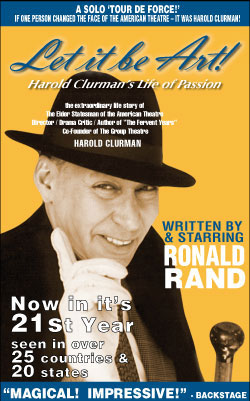Jamie Lee McMahan
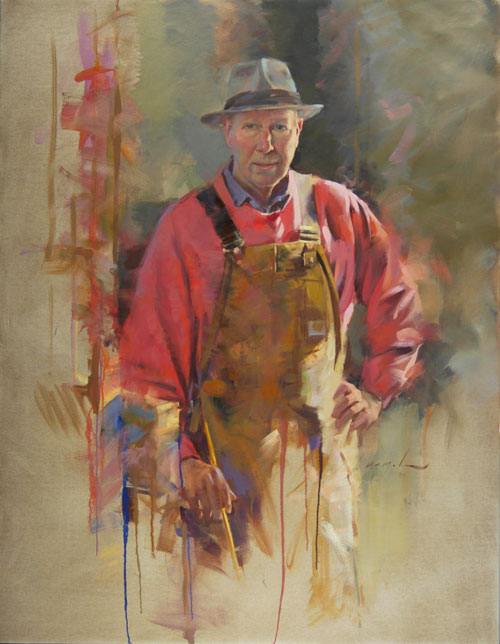
Self-portrait by Jamie Lee McMahan
Received the Portrait Society of America International Competition’s People’s Choice Award in 2007. Mr. McMahan became a full-time professional portrait painter in his forties. Influenced by master painters Kinstler, Bettina Steinke, Joe Bowler, John Howard Sanden, and Fred Rawlinson, he has painted people in all walks of life and professions, including Supreme Court Justice Sonia Sotomayor and award-winning author of “Roots,” Alex Haley. Mr. McMahan maintains a studio in Memphis, Tennessee.
You’ve used a quote by the Italian master, Gian Lorenzo Bernini, “A person gives himself away just before or just after speaking,” when you’ve described your approach in capturing who a person is when you paint their portrait.
As a portrait artist, I am trying to get the ‘real’ person to reveal themselves, and that my work captures truth and honesty in my portrait, particularly to give the painting a real sense of justice and bring out the person underneath the surface. I try and talk to my subjects to get them relaxed at a sitting so that they’re more themselves.
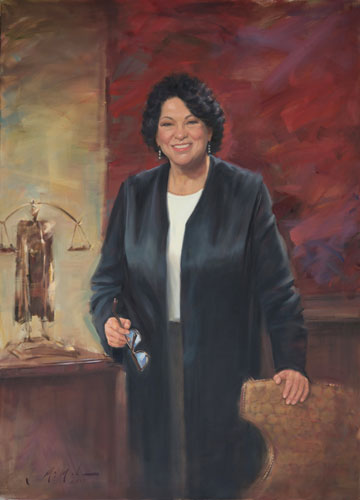
Portrait of U.S. Supreme Court Sonia Sotomayor by Jamie Lee McMahan
Of course, the mechanical part of setting up the portrait is necessary. For example, if I’m painting a judge, it's necessary to show them in a dignified pose. I work to have a good sense of design, with good lighting. I can’t emphasize enough how important all these mechanical things are necessary to put into place up front to bring the person out in the portrait.
John Singer Sargent preferred to not know his subject, but he was so fast and so brilliant and could capture his subject on the spot without getting to know them in depth.
You have also talked about important woman artists in your Talks, that they haven’t always received the due they deserve.
Yes, there have been women artists all throughout history which haven’t gotten credit. In particular I could mention: Elizabeth Shoumatoff, who painted Franklin Delano Roosevelt’s un-finished portrait; there was Helen Carlton, who did Scarlett O’Hara’s portrait exhibited at the Margaret Mitchell House; Jean McClain painted Edith Vanderbilt’s portrait, and an artist I came across recently: Marie Goth, a rural artist.
When I travel to do commissions, I sometimes visit galleries or I’d be working someplace and I’d come across an artist I didn’t know anything about, and I’m always very impressed; it’s one of the joys in my life in discovering an artist I didn’t know anything about. Then I go out of my way to learn everything I can about who they are and what they did. It’s like finding a gold nugget; their work resonates so much with me.
You actually began in a totally different career and field. How did you decide portrait painting was who you are?
Well, when I was growing up, art really wasn’t taken very seriously in the community. I grew in a rural community, and in school, there wasn’t an art teacher. Now my mother could do anything; she was smart. She raised our family and she could draw, and she would entertain my brother and I drawing cowboys; it was like magic to me.
I started drawing all through school, then in college I took courses and became a little more serious, but I really still didn't recognize the promise of an art career.
You’ve included master artists Daniel Greene and Everett Raymond Kinstler as strong influences in your career.
First of all, I did everything wrong. A lot of people in my field know they want to be an artist or a painter or an illustrator early on. I didn’t have a clue actually, so I became a salesperson and went into a business career. It was only in middle of my life, in my forties, that I found that a career as a portrait painter was an option I could pursue.
The first time was when I went to a workshop with Daniel Green in upstate New York. It opened a window to me. The next year I studied with Raymond Kinstler in Maine for a week. He said to me: “Have you thought about doing this for a living?”
Well, that’s all I needed to hear. It pushed me over the edge and started it a new career for me, but I had no clients, really no mentors except for Kinstler. It was leap of faith and I just jumped and began to do it any way I could.
One of those whose portrait you painted was the renowned author, Alex Haley. How did that come about and what was that sessions like painting him?
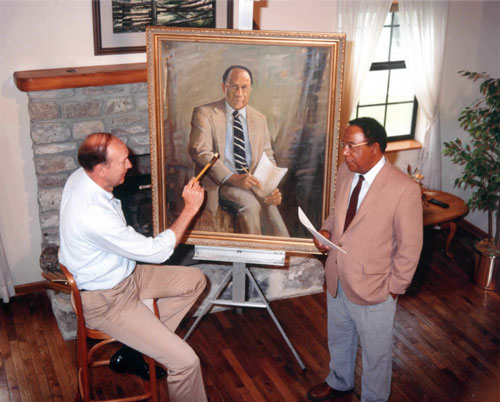
Jamie Lee McMahan painting his portrait of Alex Hailey
That was a stroke of luck. When I was introduced to him, I asked him if I might be able to paint his portrait. He said: “Oh, sure.” He was very warm; you don’t always get that from famous people.
When I painted his portrait, we talked about that part of western Tennessee where Chicken George had moved to, and where he’s buried along with many members of his family.
Alex’s grandparents had a house in the small town of Henning, and he had grown up there, living with his grandparents as much as with his parents. So, consequently he’d come back to visit, and he had some property there. We found out we actually had a lot of mutual friends.
I ended up visiting him several times and stayed at his place. We’d talk about his roots when I painted him, about what happened to his boyhood friends, his family’s history. I pretty much grew up in the same area where his family’s from; we actually lived a few miles up the road from one another. When I told him, I lived next to a country church growing up, which had a big bell that would ring across the fields, he knew exactly where it was.

What was your experience creating Supreme Court Justice Sonia Sotomayer’s portrait?
I have actually painted her twice. The first time, the Yale Law School inquired about my interest in painting Justice Sonia Sotomayor. She had graduated from the Yale Law School in 1979. I had been to a previous unveiling of a portrait of hers at the New York Bar Association.
There was a three-round selection process, and I received the commission. I ended up sending different studies to her assistant. She likes modern art and didn’t want a traditional setting or a Queen Anne chair in the painting.
When we went to a dinner down in the West Village that used to be a ‘speakeasy’ in the 1920’s with close friends, I sat across from her at a tiny little table; there were Secret Service people all around. She was really just down-to-earth and straightforward, and I felt she was generally interested and having a conversation.
She actually surprised me when we met. The first thing she said to me: “Jamie, it’s good to meet you. How come you never got married? Why is that?” Well, that certainly caught me by surprise. I didn’t really have good answer. The best I could reply was: “I’ve never been in one place long enough for it to happen.”
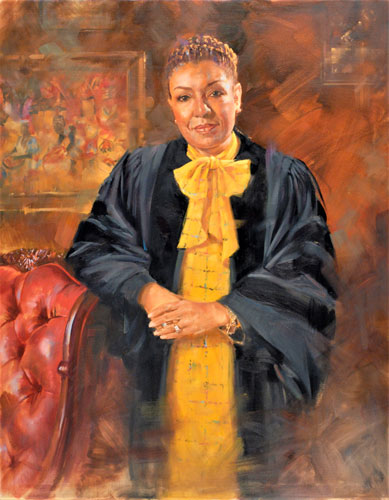
Portrait of Georgia Supreme Court Justice Leah Ward Sears by Jamie Lee McMahan
We’re living in a very different world of technology today, where many images can be captured and created in a matter of moments. Do you feel there still remains a strong need for a portrait captured in paint on a canvas?
Actually, I’m not sure if the need is as strong as it used to be. It may not be as appealing as it once, however, there still remains quite a few people who do want to see a portrait hanging on their wall, besides judges, business leaders, university presidents and so forth. Also, the market of representational art has been growing; there’s quite a few strong paintings coming out by excellent representation artists, and that’s certainly a good thing for portrait painting.
Do you see art and painting remaining something essential in our lives today?
I think because of shows like the ones you see on PBS and documentaries and movies about artists, all of that makes people aware of how important it is. And there are quite a few amateur artists out there who love to paint. Yes, I certainly think it does affect our lives and enhance everything we do.
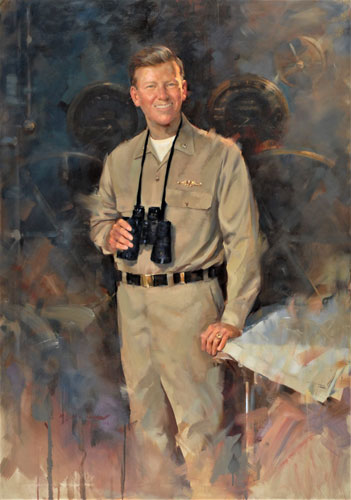
Portrait of Admiral Eugene Fluckey by Jamie Lee McMahan
Being an artist defines who I am; it is something that I certainly struggle with and strive to accomplish but I certainly hope that I’m more than an artist.
During the time I spend in front of an easel, of course, while you’re painting, your mind can wander and you begin to see there are certain parallels in my work with other activities like sports or the other work that people do, to all aspects of life.
Being an artist makes you a student of art history. It’s always been about seeing, and I really like the words of the great Robert Henri: “Art when understood is the province of every human being.”
I believe paintings channel strong story telling. We’re using a language in painting to tell stories that are more than just a drawing. They’re actually bringing meaning to many people’s lives and can also make a difference in a lot of different aspects of life.

Portrait of University of Memphis Shirley Raines by Jamie Lee McMahan
A successful painting, I believe, has a sense of mystery, just like in your work as an actor. You see it in acting, writers who create plays, in dances, in music. You always find that mystery when you’re looking at a masterpiece, at a painting by somebody like Sargent.
I’m not sure if I can really put into words why a work of art grabs your attention or why it makes you feel a certain way. I want to say that’s my goal – if I can have someone who looks at one of my paintings, to get them to feel like that – I feel like I’ve done something. •









































